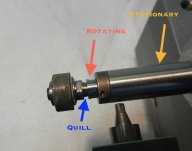I have a NR-303 spindle coming, it uses a bigger arbor which tells me the spindle and therefore bearings will be bigger also. It's only about 2mm smaller in diameter than my sleeves but I'm hoping to turn the OD down a little for more room, it should be a much more rigid set up.
Does the stationary spindle (marked yellow) go into the hole ? A little bit or a lot ?
About the quill, I'm jumping the gun here but my plan would be to make one yourself along the lines of the Big40 toolholders or whatever they call them, fits against both the taper and the face of the spindle. Will be a bit of a bitch to make but should give a measurable amount more rigidity.
May as well reveal all while I'm here ... you've got the thing to kind of grind so at least you know it's possible, now worth it to work on incremental improvements ?
Your skinny spindle thingy hangs way out, while the motor is captured in the travelling slide ? I'd make new mounts that move the whole thing back, hold the spindle right out next to its nose and let the motor hang out the back in space. That long thingy is just a tuning fork, the closer you can capture it to the grinding wheel the better. I bet it's singing a pretty song there while you grind, especially with those bearings inside whirling around.
If the stationary portion is only going in a little ways, then I'd probably actually move it back a little, capture it in the slide as close to the bearings as you can in as beefy a clamp as will fit, cast iron not aluminum, and make the quill a tad longer to reach farther down the hole, but as big as you can. It seems like you'd gain more that way than lose, those bearings spinning around are making bad bad bad, bad vibrations and the tuning fork aspect of the setup magnifies it.
And one more thing that
might help even a little but would be fun to do at least : on a heald, the table weighs I dunno, about a thousand pounds ? Yours is lighter
 but
but you could probably pull it out, counterbore a grid of 1" diameter recesses, then pour lead into those. Lead is good at damping and the weight plus the vibrations-absorbing might help. Or use carbide, but can't melt and pour that, not as much fun. A little more mass, a little more damping, can't hurt. Might even take fifteen minutes per off the grind time, and I know you'd rather mess with this than just get a little Bryant














